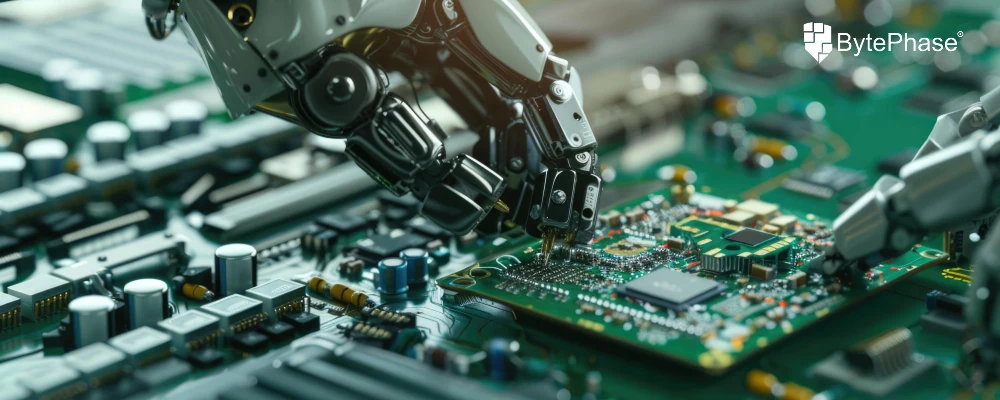The Future of Repair Shops: AI, Robotics & Automation – What’s Next for Your Business?

Introduction
The electronics repair industry, often seen as hands-on and traditional, is on the cusp of a profound transformation. As we move further into 2025, Artificial Intelligence (AI), robotics, and advanced automation are no longer just concepts for manufacturing plants; they are becoming tangible realities that will redefine how repair shops operate worldwide.
For forward-thinking owners, this isn’t a threat, but an immense opportunity. Embracing these technologies can lead to unprecedented efficiencies, accuracy, and customer satisfaction. The question isn’t if these changes will arrive, but how soon and how you can prepare your business.
How is AI Revolutionizing Repair Diagnostics? (Smarter, Faster Fixes)
One of the most immediate impacts of AI in the repair sector is in diagnostics. Traditionally, technicians rely on experience and manual troubleshooting. AI changes the game:
- Pattern Recognition: AI algorithms can analyze vast datasets of past repair logs, common failure points, and device schematics to identify issues with unparalleled speed and accuracy. An AI-powered system can pinpoint a root cause much faster than a human might.
- Predictive Maintenance: Imagine a system that alerts a customer to a potential battery failure or hard drive issue before it actually crashes. AI analyzes device telemetry and usage patterns to predict component lifespans, allowing for proactive, scheduled repairs.
- Computer Vision: AI-driven computer vision systems can inspect devices for microscopic defects, cracks, or component damage, assisting technicians in identifying subtle issues that the human eye might miss.
Are Robots Taking Over the Repair Bench? (Precision & Efficiency)
While the image of fully autonomous robots fixing complex devices is still largely futuristic, robotics and automation are already impacting repair shops in several ways:
- Automated Material Handling: Robots can assist with sorting, organizing, and retrieving parts from inventory, reducing manual labor and errors.
- Precision Tasks: For highly repetitive or extremely precise tasks like micro-soldering, screen detachment, or component placement on circuit boards, robotic arms can offer consistency and accuracy beyond human capability, reducing re-work.
- Workflow Automation: Beyond physical robots, software automation streamlines processes like initial device check-ins, automated customer updates, and inventory reordering.
Beyond the Bench: AI’s Role in Customer Experience and Operations
AI isn’t just for the technical side; it’s transforming the entire customer journey and back-office operations:
- AI-Powered Customer Support: Chatbots and virtual assistants can handle initial customer inquiries, provide basic troubleshooting, answer FAQs about pricing or services, and even schedule appointments 24/7. This frees up human staff for more complex interactions.
- Optimized Resource Allocation: AI can analyze repair demand, technician availability, and part stock to optimize scheduling and ensure the right technician with the right skills is assigned to the right job at the right time.
- Sustainability: AI can aid in reverse engineering damaged components for repair rather than replacement, and help optimize recycling processes by identifying salvageable materials from old devices, contributing to global sustainability efforts.
How Your Repair Business Can Prepare for the Future (And How BytePhase Helps)
Embracing this future isn’t about replacing humans with robots overnight, but about augmenting human capabilities and optimizing processes. Here’s how you can prepare:
- Invest in Data Management: AI thrives on data. A robust repair shop management system is paramount. Every repair log, every diagnostic note, every part used, and every customer interaction becomes valuable data for future AI insights.
- Standardize Workflows: Automation requires clear, repeatable processes. Document your repair steps, diagnostic procedures, and communication protocols. This makes it easier to integrate automated tools later.
- Upskill Your Technicians: The role of the technician will evolve. They’ll need to work with AI and automated tools, interpreting data, overseeing robots, and handling the complex, nuanced repairs that AI can’t (yet) do. Invest in continuous training.
- Adopt Integrated Software: The key to this transformation is a central nervous system for your business.
BytePhase is designed to be the foundational platform that enables your repair business to seamlessly integrate with and capitalize on these future trends:
- Data Aggregation Powerhouse: BytePhase meticulously captures every detail of every repair, creating the rich dataset essential for future AI diagnostics and predictive analytics. Your repair history becomes a powerful learning tool.
- Workflow Automation: BytePhase already automates critical tasks like ticketing, customer communications, inventory alerts, and invoicing, freeing up your team to focus on higher-value work and preparing your business for further automation.
- Integration Readiness: As new AI diagnostic tools or smart equipment emerge, BytePhase is built to integrate, allowing seamless data flow between these advanced tools and your core business operations.
- Performance Insight: Leverage BytePhase’s robust reporting to identify trends, technician efficiency, and areas where automation or AI could yield the biggest improvements.
- Scalability for Innovation: BytePhase provides the stability and scalability needed to experiment with new technologies without disrupting your core business, positioning your shop at the forefront of the global repair industry.
The future of electronics repair is intelligent, efficient, and interconnected. By strategically adopting AI, robotics, and automation, and by leveraging a powerful platform like BytePhase, your repair shop can not only survive but thrive in this evolving landscape, delivering unmatched speed, accuracy, and service quality to customers worldwide.




